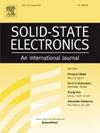Analytic model for organic field-effect transistors based on Vissenberg-Matters mobility model
IF 1.4
4区 物理与天体物理
Q3 ENGINEERING, ELECTRICAL & ELECTRONIC
引用次数: 0
Abstract
The fundamental I–V formula of an organic field effect transistor (OFET) is reformulated as double integral of mobility function by using the Poisson’s equation. The reformulated I–V formula overcome the divergence of the integrand in original I–V formula and is convenient not only for further analytic derivations but also for numerical calculations. An analytic binomial expansion for arbitrary power is proposed to analytically derive the OFET model based on Vissenberg-Matters (VM) mobility model being able to consider all terms deduced from the completed VM model. The numerical calculations for six OFET made of four kinds of materials show that the matching degree between theoretical I–V curves and the experimental data is satisfactory for completed model, but evident deviations for ID–VD curves exhibited in usual treatment that only considering first term deduced from the VM model. It is important to consider all terms in modelling OFET to ensure accuracy and reliability for extraction of parameters. These are useful for practical applications and device simulations.

基于Vissenberg-Matters迁移率模型的有机场效应晶体管解析模型
利用泊松方程将有机场效应晶体管(OFET)的基本I-V公式重新表述为迁移率函数的二重积分。重新表述的I-V公式克服了原I-V公式中被积函数的发散性,不仅便于进一步的解析推导,而且便于数值计算。提出了一种基于Vissenberg-Matters (VM)迁移率模型的任意幂次解析二项式展开式,以解析导出OFET模型,该模型能够考虑由完成的VM模型推导出的所有项。对4种材料制成的6个OFET的数值计算表明,理论I-V曲线与实验数据的匹配程度令人满意,但通常只考虑从VM模型推导出的第一项时,对ID-VD曲线的处理存在明显偏差。为了保证参数提取的准确性和可靠性,在对OFET建模时考虑所有的项是很重要的。这些对于实际应用和设备模拟非常有用。
本文章由计算机程序翻译,如有差异,请以英文原文为准。
求助全文
约1分钟内获得全文
求助全文
来源期刊

Solid-state Electronics
物理-工程:电子与电气
CiteScore
3.00
自引率
5.90%
发文量
212
审稿时长
3 months
期刊介绍:
It is the aim of this journal to bring together in one publication outstanding papers reporting new and original work in the following areas: (1) applications of solid-state physics and technology to electronics and optoelectronics, including theory and device design; (2) optical, electrical, morphological characterization techniques and parameter extraction of devices; (3) fabrication of semiconductor devices, and also device-related materials growth, measurement and evaluation; (4) the physics and modeling of submicron and nanoscale microelectronic and optoelectronic devices, including processing, measurement, and performance evaluation; (5) applications of numerical methods to the modeling and simulation of solid-state devices and processes; and (6) nanoscale electronic and optoelectronic devices, photovoltaics, sensors, and MEMS based on semiconductor and alternative electronic materials; (7) synthesis and electrooptical properties of materials for novel devices.
 求助内容:
求助内容: 应助结果提醒方式:
应助结果提醒方式:


